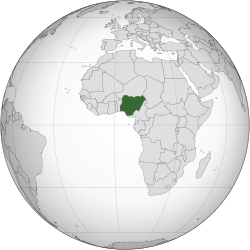
Back الجمهورية النيجيرية الثانية Arabic Dua Niĝeria Respubliko Esperanto Jamhuriyar Najeriya ta biyu Hausa Republik Nigeria Kedua ID Mba Naịjirịa nke Abụọ IG Segunda República da Nigéria Portuguese Ìgbà Òṣèlú Èkejì Nàìjíríà Yoruba 尼日利亚第二共和国 Chinese
Federal Republic of Nigeria | |||||||||
|---|---|---|---|---|---|---|---|---|---|
| 1979–1983 | |||||||||
| Motto: "Unity and Faith, Peace and Progress"[1] | |||||||||
| Anthem: Arise, O Compatriots[1] | |||||||||
 | |||||||||
| Capital | Lagos | ||||||||
| Common languages | English · Hausa · Igbo · Yoruba · and other regional languages | ||||||||
| Religion | Christianity · Islam · Traditional beliefs | ||||||||
| Government | Federal presidential republic | ||||||||
| President | |||||||||
• 1979–1983 | Shehu Shagari | ||||||||
| Vice President | |||||||||
• 1979–1983 | Alex Ifeanyichukwu Ekwueme | ||||||||
| Legislature | National Assembly[2] | ||||||||
• Upper house | Senate | ||||||||
• Lower house | House of Representatives | ||||||||
| Historical era | Cold War | ||||||||
| 1 October 1979 | |||||||||
| 31 December 1983 | |||||||||
| Area | |||||||||
| [3] | 923,768 km2 (356,669 sq mi) | ||||||||
| Currency | Nigerian naira | ||||||||
| Time zone | UTC+1 (WAT) | ||||||||
| Drives on | right | ||||||||
| ISO 3166 code | NG | ||||||||
| |||||||||
| Today part of | Nigeria Cameroona | ||||||||
| |||||||||
The Second Nigerian Republic was a brief formation of the Nigerian state which succeeded the military governments formed after the overthrow of the first republic.
- ^ a b Ugorji, Basil (2012). From Cultural Justice to Inter-Ethnic Mediation: A Reflection on the Possibility of Ethno-Religious Mediation in Africa. Outskirts Press. p. 183. ISBN 9781432788353.
- ^ "The Constitution of the Federal Republic of Nigeria (1979)" (PDF). p. 21. Archived from the original (PDF) on 9 December 2006.
- ^ Oshungade, I. O. (1995). "The Nigerian Population Statistics" (PDF). 1995 Directory of Nigerian Statisticians. 2: 58. Archived from the original (PDF) on 27 February 2013.

